Objective: To compare the in vitro stability of acetabular cups with peripherally reinforced fixation in a model of uncemented total hip replacement in dogs.
Sample: 63 polyurethane foam blocks and 3 acetabular implant designs: hemiellipsoidal (Model A) and 2 models with equatorial peripheral fins (Model B with 1 level and Model C with 2 levels of fins).
Methods: 2 loading patterns-edge loading and push-out tests-were performed until failure and peak forces were recorded. Implantation behavior was visually assessed and the required seating force was assessed using a force-displacement curve.
Results: Model B showed significantly lower peak force than Model A in edge loading tests with standardized impaction. In the push-out test, Model A had a greater maximal force than Models B and C, with mean maximal forces of 213.7 N, 139.4 N, and 138.9 N, respectively. In the seating force test, Models B and C required a higher force for 2-mm deep implantation (362.0 N and 361.6 N, respectively) than Model A (194.4 N), and were associated with dorsal tilting of the components.
Clinical relevance: Our results suggest that cups with a peripheral design (B, C) have less primary stability than hemiellipsoidal cups (A). Furthermore, models with peripheral fins (B, C) appeared to have incomplete seating if a higher force was not used during implantation and, therefore, the risk of malpositioning was increased. These data indicate that hemiellipsoidal cups provide the same or better initial stability and require a lower impaction force.









